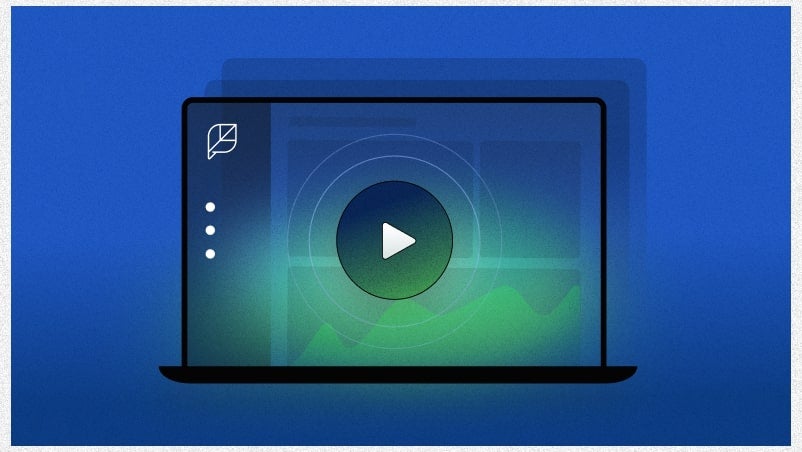
Customer Care
What is Customer Care? Tips for Building a Loyal Following
Dive into this complete guide on customer care to learn how empathetic support and proactive engagement can secure lifelong customers. It will give you insights on how to set your brand apart and inspire loyalty with real-world examples for success.
Reading time 12 minutes
Published on May 24, 2023

Table of Contents
Summary
- Stellar customer care inspires long-term loyalty and brand advocacy.
- Customer care extends beyond mere problem resolution. Quality customer care encompasses empathy and support. It is vital for building emotional connections and fostering brand loyalty.
- Setting up a successful customer care team is about maintaining a balance between efficiency and personalization. It involves consistent brand voice, providing the right tools, syncing cross-departmentally, training and automation.
A coworker told me that when she posted about her favorite makeup brand, they sent her free products as a thank you. That story made me want to shop from and post about that brand—then, and years later. All because of stellar customer care.
Customer care has the potential to secure life-long, loyal customers who not only keep coming back, but also tell their friends about your business, too. And while one-to-one interactions seems small, they have long-term business benefits and create an ongoing revenue stream from dedicated customers.
Providing stellar customer care is a marathon—not a sprint. But it’s achievable and scalable, especially on social. In this article, we’ll take you through customer care examples, the metrics you need and more to build a loyal following. Feel free to jump ahead with the table of contents.
Social Customer Care by Sprout Social
What is customer care?
Customer care is the empathetic support customers receive from your brand—not just after they’ve made a purchase but before and during the process. It extends beyond checking the resolved box and goes the extra mile with the goal of building emotional connection with customers, and loyalty.
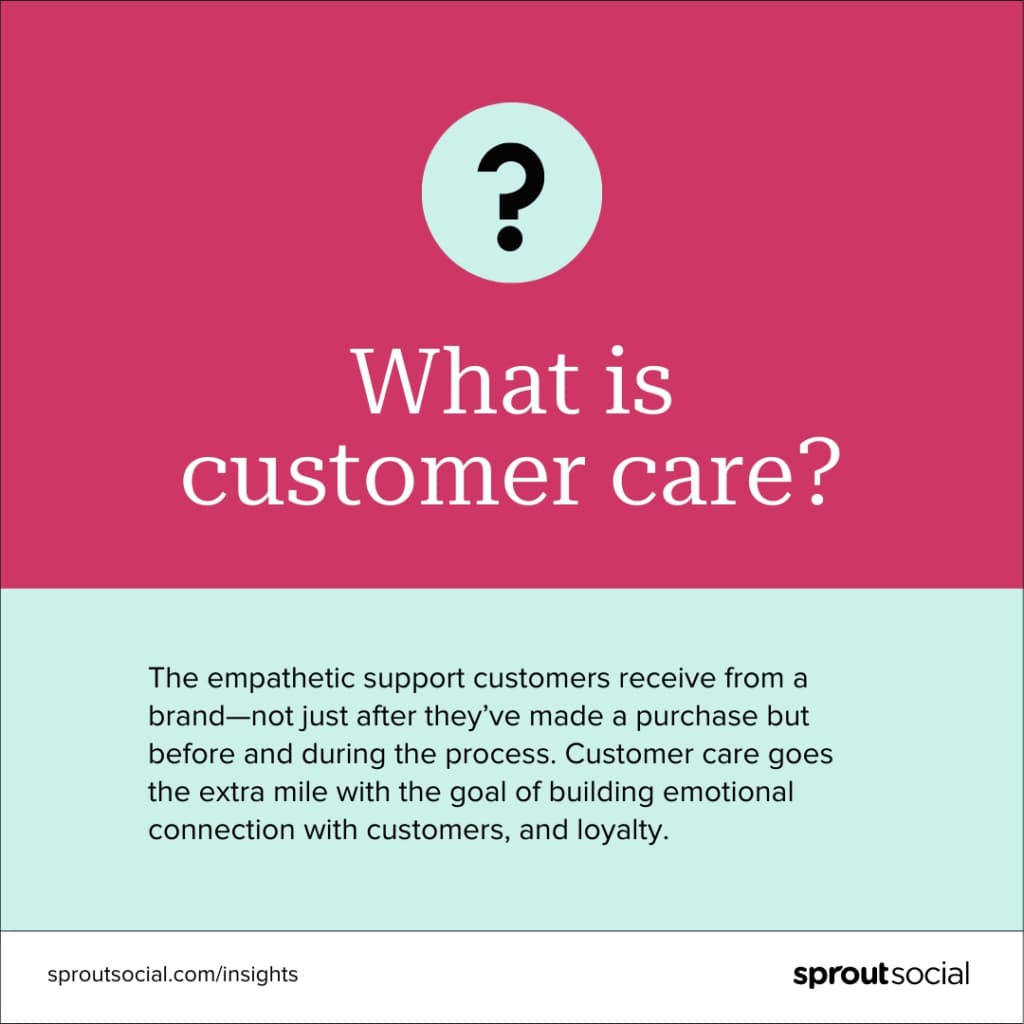
“Consumers are more sophisticated today than ever before, and have extremely high expectations for the brands they choose to interact with,” Skylar Piro, Director of Customer Success, Key Accounts at Sprout Social tells us. “Care agents are the front line and have the tough job of making sure customers are not only happy with each interaction but also find value.”
How are customer care and customer service different?
Customer service, experience, relations and success (or support) are often used interchangeably. While they all aim to solve customer needs, they have slightly different goals.
And customer care can be practiced through all of them. Think of it this way: customer care is the fuel that powers the entire engine.
With that in mind, let’s compare:
Customer care vs. customer relations
Customer relations is generally broader than customer care, and is more business-focused while care is more connection-focused. Customer relations greases the gears that keeps the whole of the engine running smoothly.
Where customer care is about inspiring loyalty through one-on-one interactions that may not be revenue-driven, relations involves the actual strategies used across an entire brand to provide a great experience for customers and prospects to generate revenue through loyal fans.
Customer care vs. customer experience
Customer experience is also broader than care, and may not even include interacting with a customer-facing agent. It is the engine that brings all the parts together to guide interactions with customers.
Customer experience is the whole of a person’s experience with a brand. Think: the products they buy and use, the in-person experiences they have with retailers, even the responses they receive on social.
Customer care vs. customer success
If customer care is the fuel, customer success is the training manual.
If you’ve ever joined a paid tool or service—like Canva or Mailchimp—customer success predicts what you’ll need to get the most out of a service, product or experience. It’s more technical, can involve resources like digital training videos and helps customers successfully use the product or service—and remain a paying subscriber or member.
While customer success is focused mainly on existing customers, care can include those who are still prospective, such as social audience members.
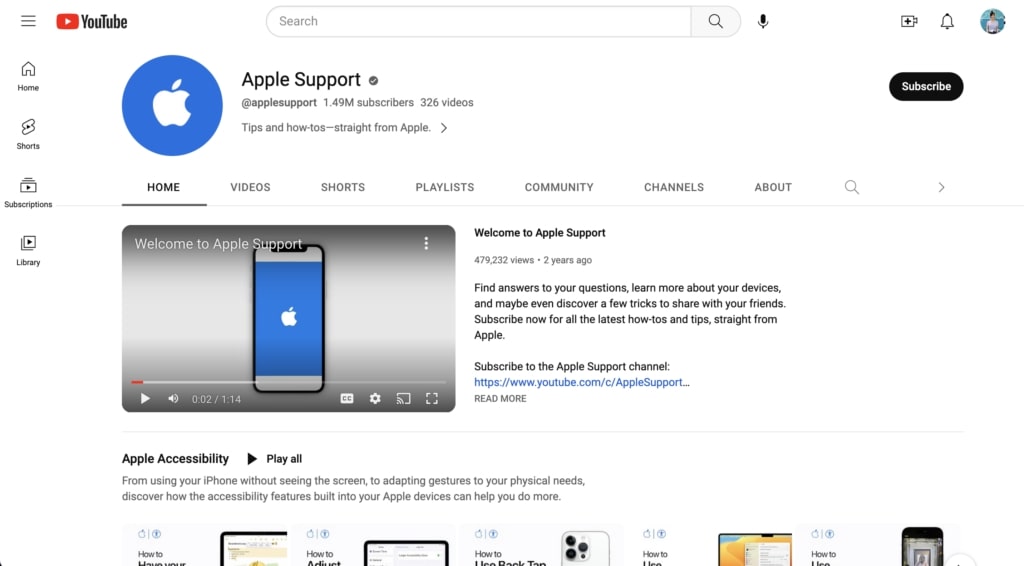
Source: YouTube
Customer care vs. customer service
If you’ve ever asked a brand a question about their hours on social, or live-chatted on the website about getting a refund, this is customer service in action. It’s the reactive assistance a brand provides, or the mechanics that fix issues in the customer experience engine.

Customer service on social, or social customer care, is differentiated from service in that it starts before a customer reaches out about a product or service, like in casual interactions on social media. That includes responding to complaints and rewarding compliments.

Source: Twitter
What are the benefits of customer care?
Poor care can cost you money. According to The Sprout Social Index™, almost three-quarters of consumers agree if a brand don’t respond to customer care questions on social, they will buy from a competitor next time.
Stellar customer care comes with business-wide benefits. A stand-out customer service strategy has the potential to grow your entire org and customer loyalty.
Here are some of the top benefits.
Sets your brand apart from the competition
Stand-out customer care sets your brand apart from others—especially if their efforts are lackluster.
It can even make you newsworthy and inspire customers to choose you over competitors. According to Zendesk, 60% of consumers have bought something from one brand over another based on the service they expect to receive.
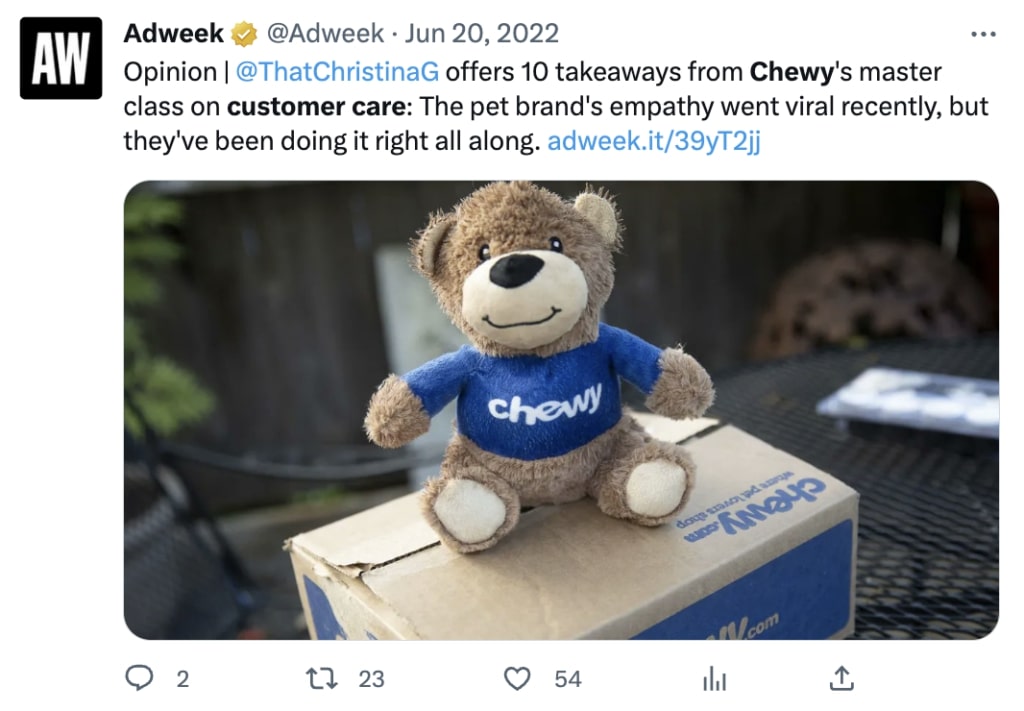
Source: Twitter
Builds customer loyalty and connection
Building emotional connections with customers is at the heart of customer care—and it goes a long way. As Skylar put it, “Customer care has the ability to make fans for life—you always remember the companies that you interacted with that made it easy and fun.”
According to Sprout’s #BrandsGetReal report, when consumers feel connected to a brand, they’re more likely to buy from them over competitors, recommend them to a friend and be loyal to that brand. And this can lead to growing your bottom line by retaining a consistent revenue stream from loyal customers.
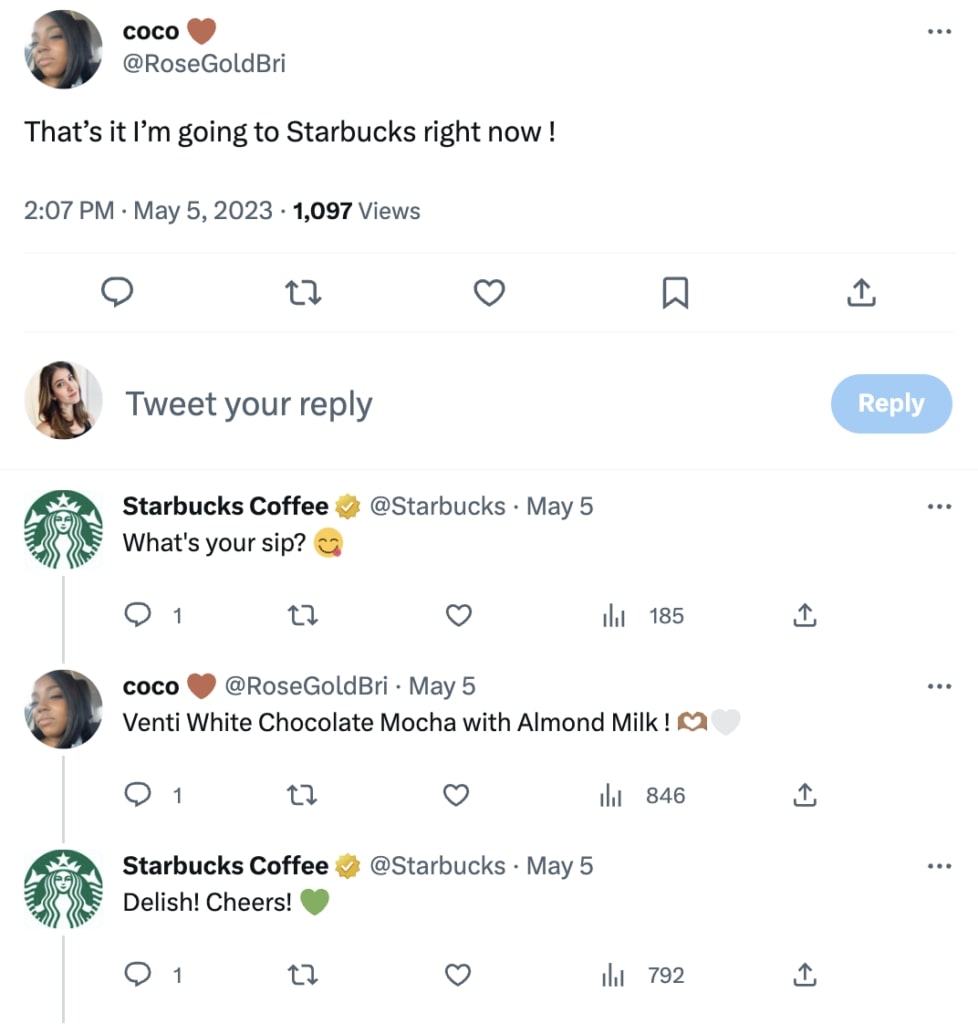
Source: Twitter
Builds customer retention and good word-of-mouth
Great customer care experiences inspire people to not only keep coming back, but also to share their experience—with friends, family and their online community alike.
While a bad customer care experience can cost you sales, customer retention and your reputation. According to The Sprout Social Index™, 36% of consumers will share a negative experience with friends and family. And when that feedback is shared at the speed of social, bad news about your brand can spread like digital wildfire.
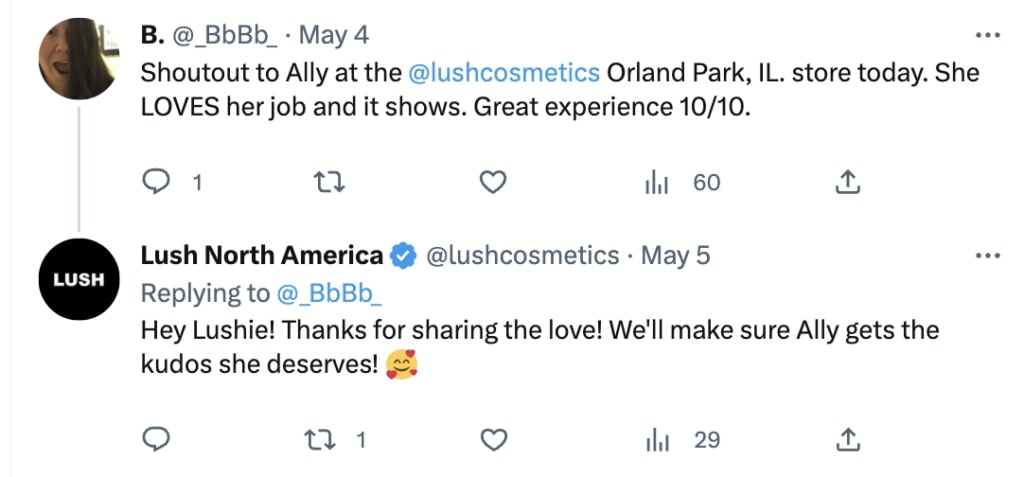
Source: Twitter
6 Tips for setting your customer care team up for success
Customer care strategies are about empathetically and proactively meeting your customers’ needs, and inspiring loyalty by going above and beyond. This can include:
- A self-service help center
- Educating customers about your product via social content
- Interacting with customers consistently (even before they make a purchase)
- Having pre-written answers for FAQs
- Offering personalized service that goes beyond automated responses
Whether you’re creating resources or a standard of excellent care, your team needs to be prepared. Here are a few ways to set them up for success.
Ensure a consistent brand and customer care voice
Your customer care voice should be consistent with your brand, and across agents. Ensuring a consistent brand voice in your customer care efforts is vital, especially when engaging in public-facing social media customer service. For example, if your brand doesn’t use puns, you shouldn’t use them when interfacing with customers.
As Skylar puts it, “Make sure that you and your team fully understand the voice of your brand and what you want that to look like to the public. This will help you set standards for how care agents respond.”
Work with your marketing or brand team to learn the brand voice. This will help you create team resources that include voice guidelines, and quick responses care agents can customize. “Create canned responses that agents can add to an existing message they are working on to respond thoughtfully, and through the lens of the business,” Skylar tells us.
And make these resources easily accessible with a tool like Sprout, where you can save responses in the Asset Library to streamline responses and tone.
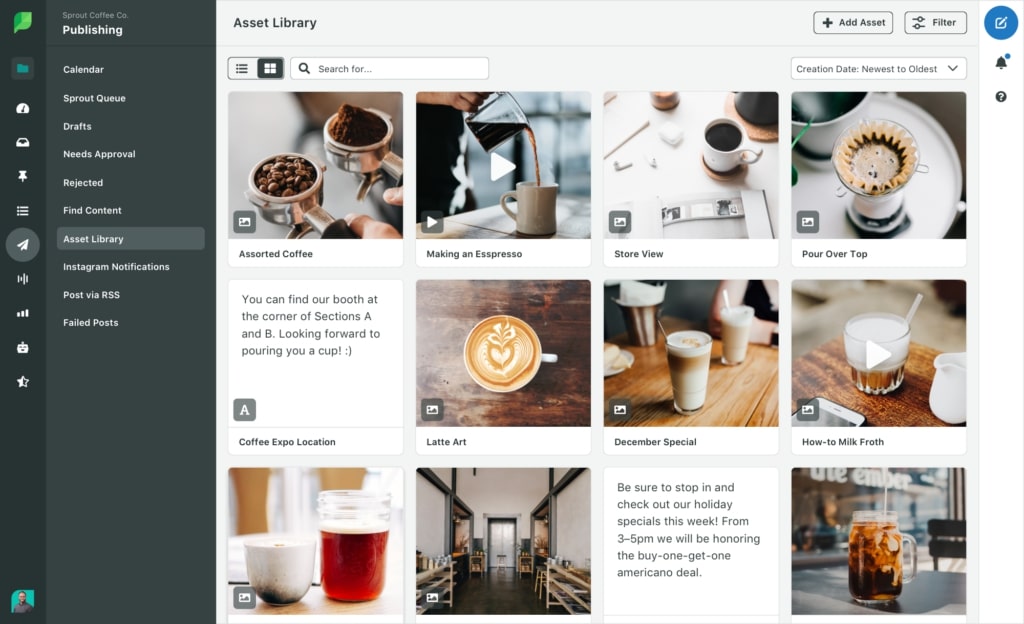
Provide the right tools
You need a way to monitor common issues that should be addressed at a company level, and a 360-degree view of customer interactions.
“Consumers expect someone to not only respond, but also meet them where they are at,” Skylar tells us. “They expect care agents to respond as if they already know what the question is and in a way that toes the line of professionalism and a response from a friend.”
Having one, centralized platform to streamline care efforts aids your collaboration and communication, breaks down silos and speeds up your process. The right tools will not only speed you up, but will empower you to identify trends that can spark org-wide improvements.
Sprout tags, for example, enable you to tag incoming messages to organize them by theme. And as Skylar explains, “Creating a tagging structure and process that your team follows from the very beginning enables you to aggregate those tags, and not only report out to the business but make meaningful change based on what your consumers are saying.”
And Sprout’s Salesforce integration reduces friction in the customer experience by providing access to a customer’s interaction history, so agents have the full picture, and customers don’t have to repeat themselves.
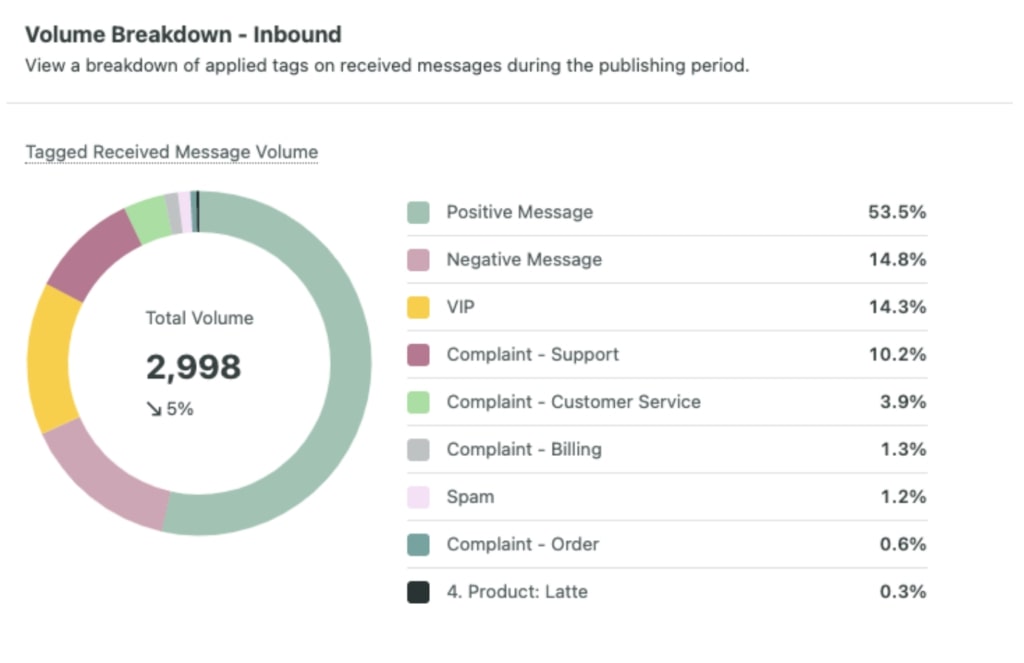
Sync with other teams
The customer data you gather can have org-wide impact. And collaborating across teams helps you better communicate with your customers, and solve problems for them.
Syncing with your product team, for example, alerts you to service disruptions customers need to know about, and also allows you to share customer feedback to improve your product.
Working with your marketing team empowers you to send and analyze email surveys for customer feedback.
And social media is an integral part of customer care—it’s often the first place customers ask questions. Your social team can field common FAQs they see on social. And you can work with them to create quick answers or social posts that preemptively answer questions. This collaboration is popular—53% of brands in The Sprout Social Index™ say their customer service team contributes to their social strategy.

Coach your team and set expectations
Coaching your team can include training them in new products or brand voice, creating canned responses, setting response speed expectations and providing guidelines for how to provide surprise and delight experiences.
Similarly, coaching your team through negative interactions will give them a strong foundation during high-stress moments. This can range from providing response templates for negative feedback, to creating an escalation management strategy.
Be open to feedback and provide feedback
No one likes getting negative feedback. But if your customers are consistently complaining about the same thing, transform that feedback into business intelligence.
Keep track of consistent pain points or complaints about your business, product, even your customer care. And turn those into FAQs, or present recommended changes to your org.
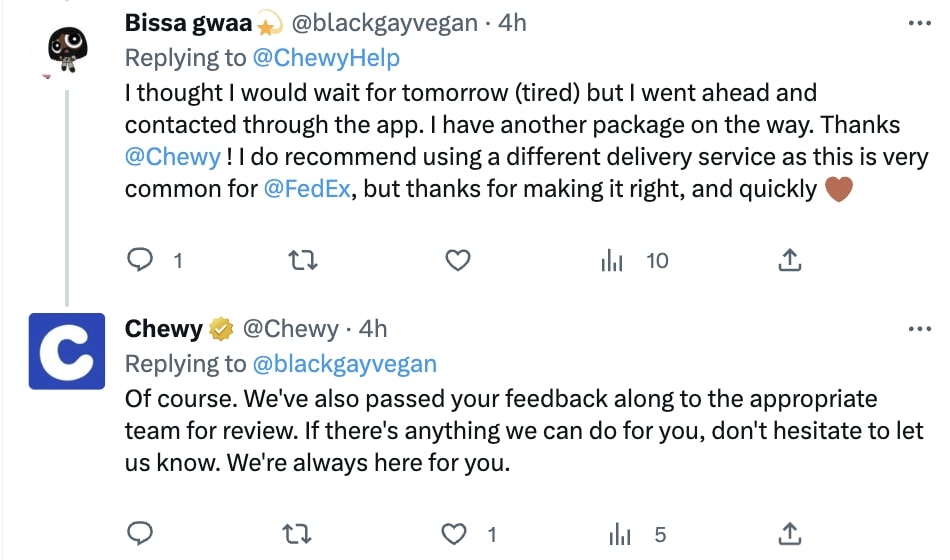
Source: Twitter
And share positive feedback with your team, too—from customers, teammates and yourself. As Skylar says, “Highlight examples of when care agents are doing an amazing job to the rest of the organization—recognition goes a long way.”
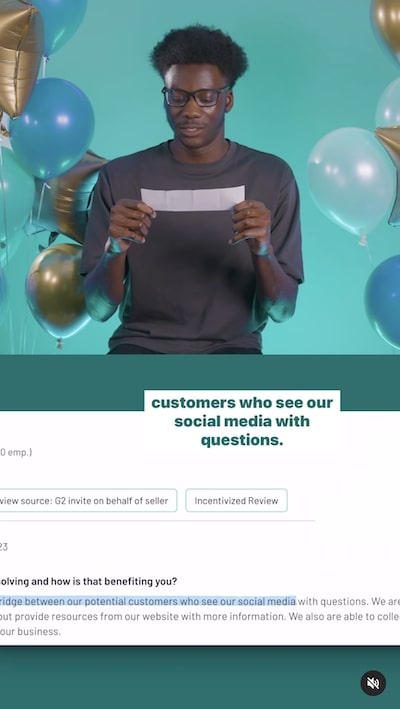
Automate where you can (but still be personable)
Customer care is built on emotional connection. But automation helps customers get fast answers. As Skylar puts it, “There are so many things that you can do today from an automated standpoint that will benefit your care team.”
In fact, according to Zendesk’s CXtrends, 77% of consumers who often interact with customer service chatbots and AI say they’re helpful for solving simple issues. The more you can automate FAQs with quick-answer resources, the more time you have to focus on larger issues.
Creating robust FAQ pages provides a hub for customers to find answers to a slew of questions. And using chatbots is an interactive way to enable customers to find answers. With a tool like Sprout’s bot builder, pull reports to measure how this self-service is alleviating work for your care and social care teams.
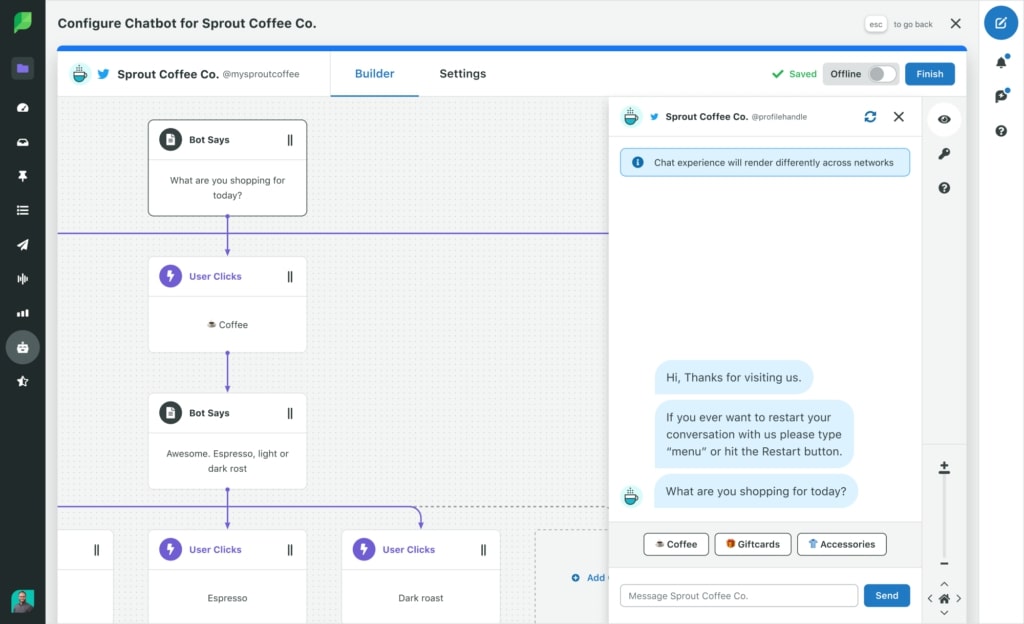
3 Customer care examples that set the standard
The best way to improve your care efforts is to learn by example. And there are stellar brands out there raising the bar for care teams everywhere.
Here are 3 stand-out customer care examples that you can learn from:
Chewy: Emotional connection
Chewy’s social media responses and above-and-beyond service serve as a masterclass in empathetic care.
In a shining example of emotional connection, Chewy regularly sends care packages and hand-written, heartfelt notes to customers who have a sick pet, or who have lost a pet.
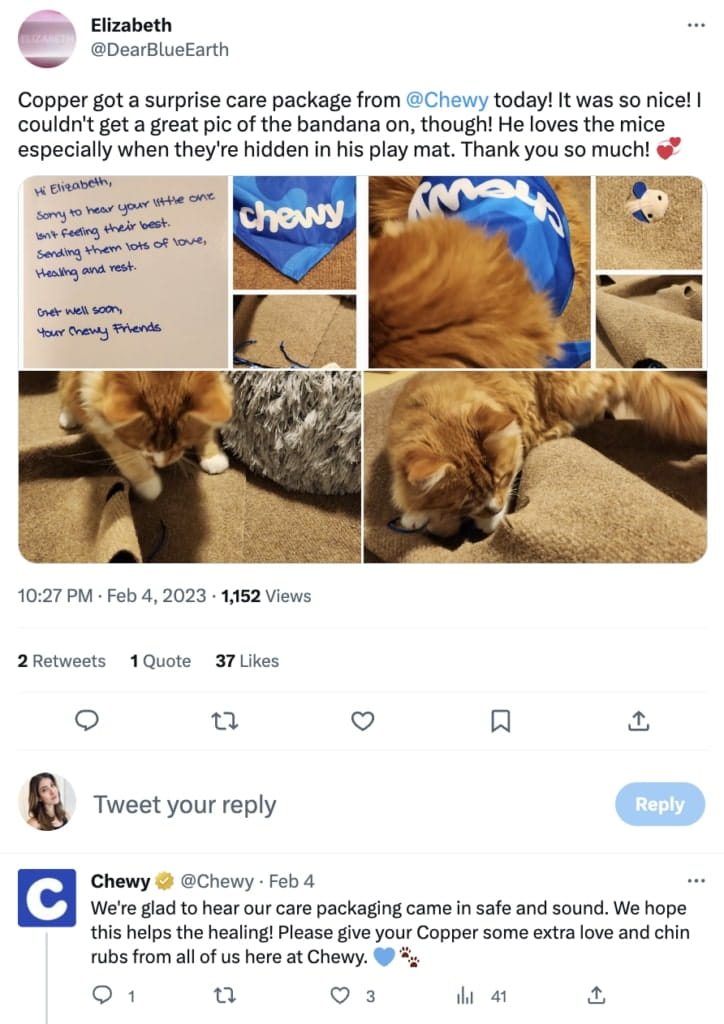
Source: Twitter
And their customer care comes through on social media, too. Many brands will provide witty, one-sentence responses. But Chewy creates connection in the comments by asking questions about their audience’s pets and having full conversation.

Source: Twitter
Brooklinen: Proactive care
The direct-to-consumer bedding brand Brooklinen excels at proactively connecting with customers, even when they aren’t directly tagged or mentioned.
Being able to respond when your brand is mentioned, but not tagged, is key to capturing conversations and rewarding loyal customers—or helping frustrated ones.

Source: Twitter
This also allows them to connect with new customers, and create better customer relationships.
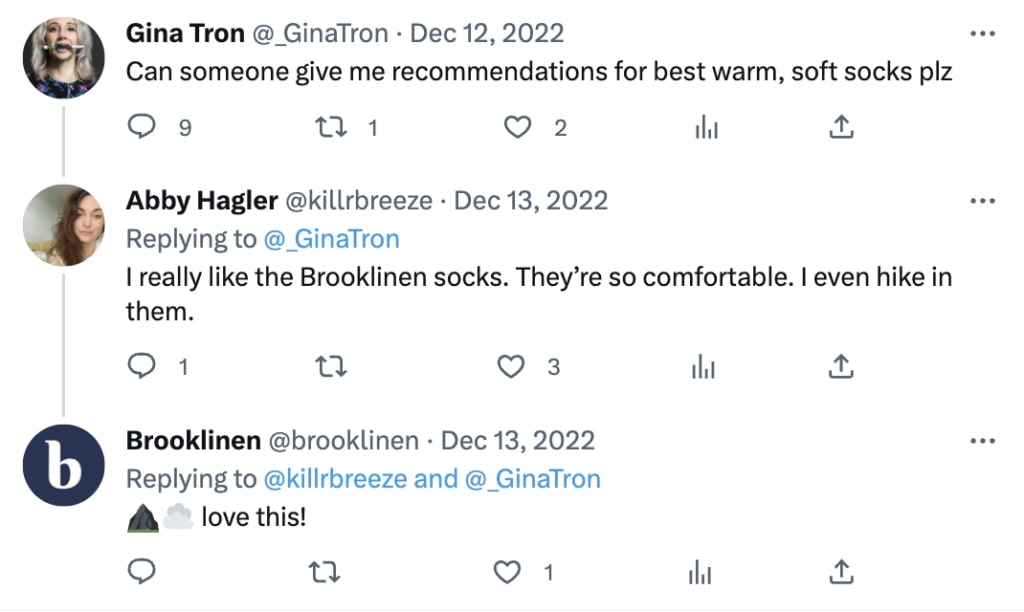
Source: Twitter
Brooklinen also goes the extra mile for their customers when the unexpected happens. Even when specific incidents are not covered in their warranty, they still empathize with the customer and explore options.

Source: Twitter
Grammarly: The need for (grammatically correct) speed
More than 30 million people worldwide use Grammarly to punch up their personal and professional writing. Many turn to social media when they have questions or feedback on the product.
The Grammarly social customer care team recognizes this as not only an opportunity to provide excellent customer service and recognition for positive brand feedback, but also as an opportunity to collect meaningful consumer insights.

Source: Twitter
However, when you have more than 13,000 messages per month, responding quickly and synthesizing feedback is no easy feat. Using Sprout, Grammarly saw an 80% reduction in average time to first response in less than two years. And Sprout’s Tagging feature helps them automate synthesizing customer feedback. Tagging reports make social media customer service data a cross-functional resource that informs product and service improvements.

Source: Twitter
How to measure your customer care efforts
The best way to measure your efforts is to leverage data and report on your success. This can be as simple as a spreadsheet, or as high-level as automated reports.
To do so, here are a few metrics to use while measuring your efforts.
Customer satisfaction score (CSAT)
Your CSAT tells you how satisfied customers are with what you offer—from your service to your product and business. You can find through customer surveys.
According to CMS Wire, good CSAT scores usually range between 75% and 85%. Calculate your CSAT percentage with this formula:
(Positive survey responses / total number of responses) * 100
A reporting platform like Sprout will do the math for you with social media feedback—all you have to do is set up your survey in Sprout.
Customer effort score (CES)
CES boils down to the amount of effort it takes customers to use your products, solve an issue through your customer care service or get in touch with a care agent.
The more effort interacting with your business is for the customer, the more frustrating and negative the experience. In fact, according to Gartner, effort is 40% more accurate at predicting loyalty of a customer than satisfaction is.
This can also be gathered through surveys sent after an interaction, or buying a product. To calculate your CES:
Responses received in customer effort surveys / total responses you received
Net promoter score (NPS)
NPS measures how your company is viewed by customers and how loyal they are to your brand.
Typically, this is gathered through surveys on a 0–10 scale that ask questions like, “how likely are you to recommend us?” These responses are broken up into three different types of customers:
- 0–6: Detractors, or unsatisfied customers.
- 7–8: Passives, or general customers who aren’t happy, but not shouting your brand’s name from the rooftops.
- 9–10: Promotors, or loyal customers who are excited about your business or products.
To calculate your NPS:
% of promoters – % of detractors
Customer sentiment
Customer satisfaction is broader, and reflects how people feel about your brand as a whole.
But checking in on overall sentiment can help you understand if changes you make to your care efforts impact the overall view of the company.
The best way to find this is with an automated social listening tool, like Sprout’s, that can mine large amounts of data, and break that into digestible insights. This will also identify keywords people use when talking about your company. If “customer care” is mentioned, you can dig in to explore what people are saying.

Average first reply time and average reply wait time
Average first reply time is how long it takes for your team to respond to a customer message. And average reply wait time is how long customers have to wait between responses.
According to The 2025 Sprout Social Index™, more than three-quarters of consumers expect a response within 24 hours. A tool like Sprout will automate this measurement for you for social responses.
Just remember: Don’t sacrifice response quality for speed. As Skylar put it, “Promote quantity and quality for your team.”
Put some thought and care into your customer care efforts
You probably remember your favorite customer care experiences—and your least favorite. Use this article to inspire your strategy and ensure your customers walk away with a shining experience that other brands will want to emulate.
As more customers head to social to connect with and talk to brands, social is only going to become more central to your care strategy. Learn more about how Sprout’s customer service solution can streamline your strategy and eliminate silos, so you can focus on putting the customer first.
Additional resources for Customer Care
How Australian brands can use chatbots to improve customer care
What is omnichannel customer service? A 2026 guide
Customer experience management: How to deliver better support
Travel Disruption Response Strategies for UK Brands in 2025
8 strategies for using AI for customer service in 2025
Best customer service software tools to use in 2025
How to master the art of customer service case management for social media
The social media customer service metrics that experts measure
Field tested tips for aligning customer service and marketing
Top customer service case management software in 2025
What is digital customer service?: A complete guide
First response time: How to win over customers with quick replies
Customer engagement models: Optimize your Customer Care strategy
The ultimate list of customer engagement metrics to monitor
8 ways customers interact and engage with your brand on social
8 customer service trends to know in 2025
How escalation management creates seamless customer service experiences
What is a Net Promoter Score (NPS) and how do you measure it?
Customer service tiers: What they are and how to create them
Customer retention strategies for 2025
Why you need an exceptional customer service strategy (and how to develop one)
Customer satisfaction score (CSAT): What it is and how to measure it
Customer service reports: What they are and tips for building them
Omnichannel customer experience: exploring seamless customer journeys
How to develop a winning customer experience strategy
What is Customer Care? Tips for Building a Loyal Following
How to make customer service efficiency an org-wide priority
3 ways customer tagging empowers brands to scale their customer responsiveness
4 tips for managing customer data end-to-end (and how social media can help)
Twitter for customer service: 7 pro tips and examples






